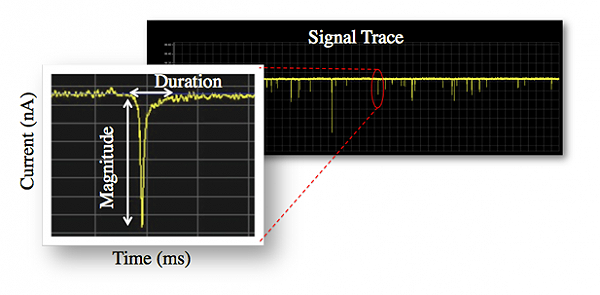Tunable Resistive Pulse Sensing on:
[Wikipedia]
[Google]
[Amazon]
Tunable Resistive Pulse Sensing (TRPS) is a single-particle technique used to measure the size, concentration and zeta potential of particles as they pass through a size-tunable nanopore.
The technique adapts the principle of resistive pulse sensing, which monitors current flow through an aperture, combined with the use of tunable nanopore technology, allowing the passage of ionic current and particles to be regulated by adjusting the pore size.


Technique
Particles crossing a pore are detected one at a time as a transient change in the ionic current flow, which is denoted as a blockade event with its amplitude denoted as the blockade magnitude. As blockade magnitude is proportional to particle size, accurate particle sizing can be achieved after calibration with a known standard. Nanopore-based detection allows particle-by-particle assessment of complex mixtures. Optimization of pore size to particle size, by adjusting the stretch of the pore, can improve measurement accuracy. Through combination with fine-control of pressure TRPS has been used to determine sample concentration and to accurately derive particle electrophoretic mobility & surface charge in addition to particle size information.Applications
TRPS has been applied in product development by nanotechnology instrument manufacturers Izon Science Ltd in the first commercially available nanopore-based particle characterization systems. These systems have been applied to measure a wide range of biological and synthetic particle types including viruses and nanoparticles. TRPS has been applied in both academic and industrial research fields, including: * Drug delivery research *Microvesicle
Microvesicles (ectosomes, or microparticles) are a type of extracellular vesicle (EV) that are released from the cell membrane. In multicellular organisms, microvesicles and other EVs are found both in tissues (in the interstitial space between ...
and exosome
Exosome may refer to:
* Exosome complex
The exosome complex (or PM/Scl complex, often just called the exosome) is a multi-protein intracellular complex capable of degrading various types of RNA (ribonucleic acid) molecules. Exosome complexes ...
s
*Virology
Virology is the scientific study of biological viruses. It is a subfield of microbiology that focuses on their detection, structure, classification and evolution, their methods of infection and exploitation of host cells for reproduction, th ...
and vaccine
A vaccine is a biological preparation that provides active acquired immunity to a particular infectious or malignant disease. The safety and effectiveness of vaccines has been widely studied and verified. ...
production
* Biomedical diagnostics
*Industrial research (e.g. paint & dye analysis)
*Microfluidics
Microfluidics refers to the behavior, precise control, and manipulation of fluids that are geometrically constrained to a small scale (typically sub-millimeter) at which surface forces dominate volumetric forces. It is a multidisciplinary field tha ...
References
{{reflist, colwidth=30em Nanotechnology Nanoparticles